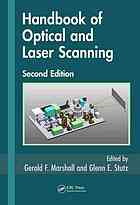(Ebook) Handbook of optical and laser scanning by Marshall, Gerald F.; Stutz, Glenn E ISBN 9781439808801, 1439808805
"Preface Optical and laser scanning is the controlled deflection of light, visible or invisible. The aim of Handbook of Optical and Laser Scanning is to provide engineers, scientists, managerial technologists, and students with a resource to be used as a reference for understanding the fundamentals of optical scanning technology. This text has evolved from three previous books, Laser Beam Scanning (1985), Optical
Scanning (1991), and Handbook of Optical and Laser Scanning (2004). Since their publication, many advances have occurred in optical scanning, requiring updating of previous material and introduction of additional scanning technologies. This new edition also adds a few chapters on scanning applications illustrating the practical use of scanning technology. Optical and laser scanning is a topic that is extremely broad in scope. It encompasses the mechanisms that control the deflection of light, optical systems that work with these mechanisms to perform scanning functions and factors that affect the fidelity of the images generated or obtained from the scanning systems. Each of these subtopics is addressed in this book from a variety of perspectives. A scanning system can be an input or output system or a combination of both. Input systems acquire images in either two or three dimensions. These systems can operate at a fixed wavelength or over a broad spectrum. They can reacquire the original light source by gathering either the specular or diffuse reflection or by fluorescing the image and acquiring the fluoresced light. Output systems direct light to produce images for applications such as marking, visual projection, and hard copy output. Ladar and many inspection systems use the same optical path to both illuminate the scene and acquire the image"-- Abstract: "Preface Optical and laser scanning is the controlled deflection of light, visible or invisible. The aim of Handbook of Optical and Laser Scanning is to provide engineers, scientists, managerial technologists, and students with a resource to be used as a reference for understanding the fundamentals of optical scanning technology. This text has evolved from three previous books, Laser Beam Scanning (1985), Optical Scanning (1991), and Handbook of Optical and Laser Scanning (2004). Since their publication, many advances have occurred in optical scanning, requiring updating of previous material and introduction of additional scanning technologies. This new edition also adds a few chapters on scanning applications illustrating the practical use of scanning technology. Optical and laser scanning is a topic that is extremely broad in scope. It encompasses the mechanisms that control the deflection of light, optical systems that work with these mechanisms to perform scanning functions and factors that affect the fidelity of the images generated or obtained from the scanning systems. Each of these subtopics is addressed in this book from a variety of perspectives. A scanning system can be an input or output system or a combination of both. Input systems acquire images in either two or three dimensions. These systems can operate at a fixed wavelength or over a broad spectrum. They can reacquire the original light source by gathering either the specular or diffuse reflection or by fluorescing the image and acquiring the fluoresced light. Output systems direct light to produce images for applications such as marking, visual projection, and hard copy output. Ladar and many inspection systems use the same optical path to both illuminate the scene and acquire the image"
*Free conversion of into popular formats such as PDF, DOCX, DOC, AZW, EPUB, and MOBI after payment.


